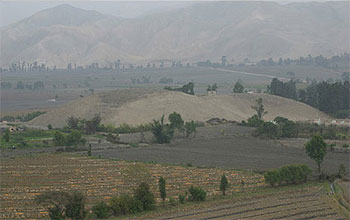News Release 04-160
Archaeologists Demonstrate Widespread Civilization Flourished on Peru's Coast Five Thousand Years Ago

Overview of a mound complex at the site of Vinto Alto in the Pativilca Valley, Peru.
December 22, 2004
This material is available primarily for archival purposes. Telephone numbers or other contact information may be out of date; please see current contact information at media contacts.
Arlington, Va.—The Norte Chico ("little North") region midway on the Peruvian coast contains the earliest known evidence of a cohesive, large-scale and organized society in the Andean region. Recent archaeological discoveries, reported in the December 23 issue of the journal Nature, reveal the extent of this civilization.
A scientist might not pick that area as a likely site for an early and extensive civilization. There was no pottery. The people did not have a staple grain-based food, usually characteristic of other early civilizations. It was not even particularly fertile – irrigation was needed to grow crops. Neverthless, the research team has shown that the Andean area was home to a hunting and gathering society that developed into a complex society with monumental architecture, large circular ceremonial structures, and a mixed economy of agriculture and marine exploitation – all earlier than any other Andean civilization.
"This area is one of the world's 'cradles of civilization,'" said John Yellen, program manager at the National Science Foundation, which partially funded the study. "So this project's evidence of a highly developed, widespread society earlier than had been thought is very important. It provides new insight into the pathways that led to the development of complex societies."
Jonathan Haas, from The Field Museum in Chicago; and Winifred Creamer, of Northern Illinois University, were part of the research team; Alvaro Ruiz was the Peruvian co-director of the project.
-NSF-
Media Contacts
Elizabeth Malone, NSF, (703) 292-8070, email: emalone@nsf.gov
Program Contacts
John E. Yellen, NSF, (703) 292-8759, email: jyellen@nsf.gov
Principal Investigators
Jonathan Haas, The Field Museum, (312) 665-7829, email: jhaas@fieldmuseum.org
Related Websites
More information about the Norte Chico project: http://www.fieldmuseum.org/panc
Look for The Field Museum's press release: http://www.fieldmuseum.org/museum_info/press_room.htm
Look for the Northern Illinois University press release: http://www.niu.edu/pubaffairs/news.shtml
The U.S. National Science Foundation propels the nation forward by advancing fundamental research in all fields of science and engineering. NSF supports research and people by providing facilities, instruments and funding to support their ingenuity and sustain the U.S. as a global leader in research and innovation. With a fiscal year 2023 budget of $9.5 billion, NSF funds reach all 50 states through grants to nearly 2,000 colleges, universities and institutions. Each year, NSF receives more than 40,000 competitive proposals and makes about 11,000 new awards. Those awards include support for cooperative research with industry, Arctic and Antarctic research and operations, and U.S. participation in international scientific efforts.
Connect with us online
NSF website: nsf.gov
NSF News: nsf.gov/news
For News Media: nsf.gov/news/newsroom
Statistics: nsf.gov/statistics/
Awards database: nsf.gov/awardsearch/
Follow us on social
Twitter: twitter.com/NSF
Facebook: facebook.com/US.NSF
Instagram: instagram.com/nsfgov


